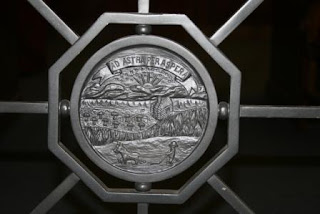


Can you see the hawk nest at the base of the flag near the top of the courthouse? Maybe you can see the sticks hanging out of the nest.


It's always nice when the employees are proud of their courthouse and these employees certainly are.


The details are as great as the overall view. There are several marble water fountains in the building as well as wooden staircase newels.

Mail is picked up at this brass mail box every day.


The art deco is very evident from the first floor pyramid design and columns. The brass rail on the second floor shows a good view of the height of the first-floor columns.




Breathtaking because of its historical retention, the wood panels with the decorative metal X's, the metal gates with the state seal, and the wall tapestries make this a highly desirable courtroom to see.
There is much more to see that depicted here. Perhaps the following information, taken from the Reno County web site, will inspire you to come explore it yourself! It's only open during the week.
The pyramid design is found all over the building and is obvious from the first floor area as you observe the following:
walnut burl panels that are evident on the main floor of the courthouse
same marble stepping stone effect around all the elevator doors plus the water fountain
bronze newel posts are the same on the stair railings as on the balcony and mezzanine
walnut burl woodwork throughout the building has a Japanese inlay as evidenced in the first floor counter area, eastern courtroom on the third floor
the baseboards on the first, second and third floors are all of marble
An artist from New York, Vincent Aderente, painted the murals in the hall and in the courtroom. The paintings in the hall are symbolical of the settlement of the plains by the American Indians and the white pioneers. A wagon train traveling across the Great Plains is further evidence of this era.
The courtroom mural overlooks the judge’s bench. This mural depicts a judgment scene with a sitting female Justice, flanked by a female Mercy and a female Execution. A mere mortal awaiting judgment stands on the other sides of Mercy and execution.
Another interesting original in the courtroom are the tapestries on the walls. The eastern window coverings were of this same design and material but have deteriorated to the point of having to be replaced.
Click here, for more historical information on the courthouse.Most courthouses in Kansas are historic with unique features. The materials used, the design, the art, the historic photos all help a person "Get Kansas!"
KE #2 Marci Penner





2 comments:
Very nice. Great photos and lots of interior shots that we don't get to see that often.
I enjoyed the tour--thanks!
Post a Comment